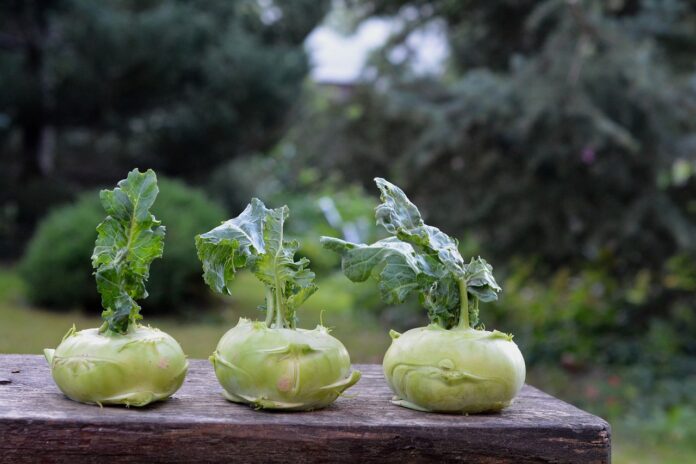Kohlrabi (Brassica oleracea, Gongylodes group) is a cool-season vegetable belonging to the Brassicaceae family, which also includes cabbage, broccoli, and kale. Known as the “German turnip,” this versatile vegetable is cultivated for its swollen stem, which is consumed as a vegetable and has a mild, sweet flavor similar to a cross between cabbage and broccoli.
Interesting Facts About Kohlrabi:
- Origins: Kohlrabi, a member of the cabbage family, originates from Northwestern Europe, likely Germany, and was introduced to North America in the 19th century.
- Name Meaning: The name “kohlrabi” comes from the German words kohl (cabbage) and rübe (turnip), reflecting its origins and turnip-like taste.
- Not a Root Vegetable: Despite its appearance, kohlrabi is not a root vegetable. Its edible part is a modified stem that grows above ground.
- Varieties: There are two main varieties: white (light green) and purple. Both have creamy-white flesh inside.
- Nutritional Value: It’s rich in vitamin C, B vitamins, and minerals like potassium, calcium, and magnesium. A 100-gram serving has only 27 calories.
- Health Benefits: Kohlrabi contains compounds that may help prevent certain types of cancer.
- Flavor Profile: Its taste is mildly sweet, with a flavor resembling a mix of radish and cucumber.
- Texture: Kohlrabi is known for its juicy, crispy texture when fresh, but it becomes woody and unpalatable when over-mature.
- Leaf Edibility: The leaves and stalks are also edible and can be prepared like spinach.
- Cooking Uses: Kohlrabi can be eaten raw in salads or cooked in soups and meat dishes.
- Plant Height: The plant grows 6–18 inches tall, depending on the variety.
- Seed Propagation: It propagates through seeds and is typically planted twice a year, in spring and autumn.
- Growth Time: Kohlrabi matures in about 55–60 days after planting.
- Storage: It can stay fresh for up to 30 days in the fridge if stored properly.
- Harvest Timing: It can be harvested as late as October, extending the growing season.
- Decorative Leaves: The leaves are sometimes used for decorative purposes in dishes.
- Animal Feed: Some varieties of kohlrabi are cultivated as feed for livestock.
- Flower Appearance: Its flowers are yellow or white, arranged in cruciform clusters.
- Seed Pods: The plant produces seed pods that are 4–5 inches long.
- Culinary Preferences: The tender inner flesh of kohlrabi is often preferred for raw dishes.
- Historical Cultivation: It has been selectively bred from wild mustard plants, like many cruciferous vegetables.
- Cool Climate: Kohlrabi thrives in cool climates with well-drained soil.
- Edible Stems: The bulbous stem is the most commonly consumed part, with the best flavor when young.
- Variety Aroma: Purple varieties are often stronger in aroma than white ones.
- Medicinal Uses: Historically, kohlrabi has been used in traditional remedies for its digestive benefits.
- Global Spread: Although European in origin, kohlrabi is now grown and enjoyed worldwide.
- Low Popularity: Despite its benefits, it remains less popular than other vegetables in some regions.
- Kitchen Versatility: Kohlrabi pairs well with butter, garlic, and citrus-based dressings.
- Child-Friendly Veggie: Its mild sweetness makes it appealing to children.
- Unusual Look: Its alien-like appearance has earned it nicknames like “space cabbage.”
